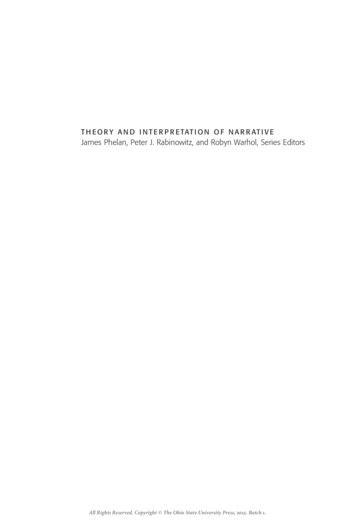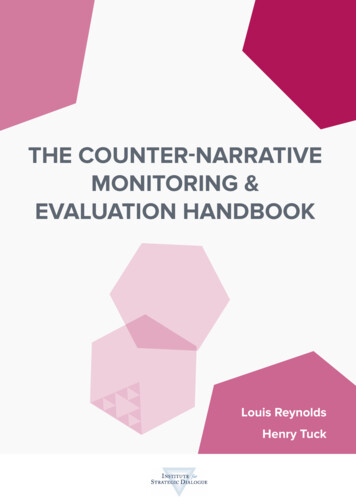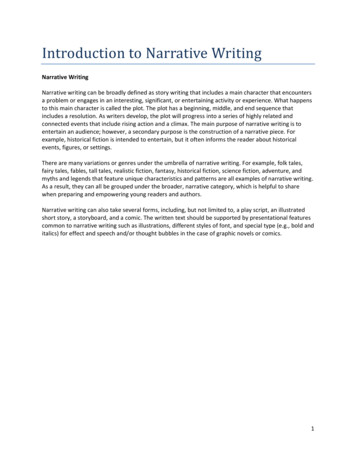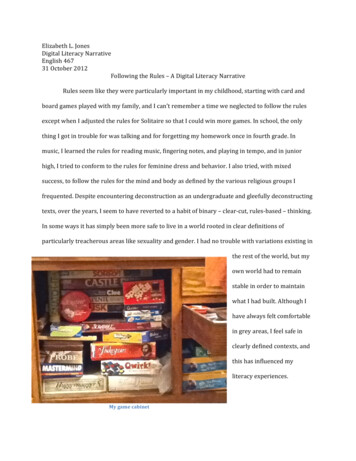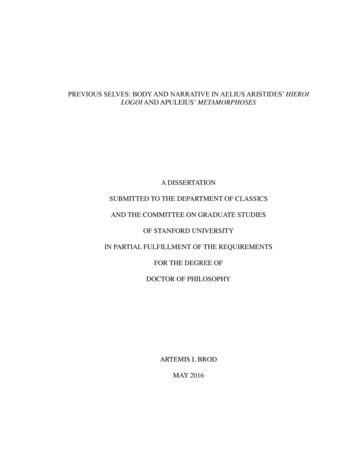
Transcription
PREVIOUS SELVES: BODY AND NARRATIVE IN AELIUS ARISTIDES’ HIEROILOGOI AND APULEIUS’ METAMORPHOSESA DISSERTATIONSUBMITTED TO THE DEPARTMENT OF CLASSICSAND THE COMMITTEE ON GRADUATE STUDIESOF STANFORD UNIVERSITYIN PARTIAL FULFILLMENT OF THE REQUIREMENTSFOR THE DEGREE OFDOCTOR OF PHILOSOPHYARTEMIS L BRODMAY 2016
2016 by Artemis Leah Brod. All Rights Reserved.Re-distributed by Stanford University under license with the author.This work is licensed under a Creative Commons AttributionNoncommercial 3.0 United States 3.0/us/This dissertation is online at: http://purl.stanford.edu/ks307yh0314ii
I certify that I have read this dissertation and that, in my opinion, it is fully adequatein scope and quality as a dissertation for the degree of Doctor of Philosophy.Susan Stephens, Primary AdviserI certify that I have read this dissertation and that, in my opinion, it is fully adequatein scope and quality as a dissertation for the degree of Doctor of Philosophy.Grant Parker, Co-AdviserI certify that I have read this dissertation and that, in my opinion, it is fully adequatein scope and quality as a dissertation for the degree of Doctor of Philosophy.Maud GleasonI certify that I have read this dissertation and that, in my opinion, it is fully adequatein scope and quality as a dissertation for the degree of Doctor of Philosophy.Andrea NightingaleApproved for the Stanford University Committee on Graduate Studies.Patricia J. Gumport, Vice Provost for Graduate EducationThis signature page was generated electronically upon submission of this dissertation inelectronic format. An original signed hard copy of the signature page is on file inUniversity Archives.iii
AbstractAelius Aristides’ Hieroi Logoi and Apuleius’ Metamorphoses have historically achievedjoint mention for their unique status as non-Christian accounts documenting a personalrelationship to a god. I start with a different observation. These texts stage an encounterwith the failure or refusal of one’s own body to function in its capacity as a vehicle forself-presentation – an especially important function to orators of the second century CE.Both texts explore the degree to which language can remake the narrator's fragmentedworld. Whereas Aristides’ Hieroi Logoi contribute to the orator’s healing process,Apuleius’ Metamorphoses uses the imagined animal body to demonstrate the elusivenature of constituting a whole self. Throughout his Hieroi Logoi, Aristides employsmetaphors to solicit his audience’s participation in reconfiguring his relationship to hisbody and his god. Apuleius’ Metamorphoses, on the other hand, dramatizes a paradox:the protagonist, Lucius, achieves his goal of literary memorialization in the form of thebook we hold, and yet the self that is on display is ultimately lost to the reader.iv
AcknowledgmentsFirst and foremost, I would like to express my gratitude to Professor Susan Stephens,without whose encouragement, support, and generous vision this dissertation would neverhave been undertaken, let alone completed. Professor Maud Gleason’s meticulousscholarship and vivid writing have been an inspiration. My heartfelt thanks to ProfessorAndrea Nightingale for her careful attention to every line of the dissertation. Thank youto Professor Grant Parker for first sparking my interest in Apuleius with a description ofan incredible-sounding ancient witchcraft trial. Without Valerie Kiszka, Lori LynnTaniguchi, and Lydia Hailu, I would be penniless and despondent. Thank you for yourmany feats of salvation. Thank you to my family for your love and humor to which Iowe whatever imagination I have. Thank you to Molly, James, and Mae for providing ahome away from home. Thank you to Federica for being my home inside our home.Also, you are my road map.v
Table of ContentsIntroduction: The Poetics of Self-Presentation in the Second Century CE . 11. Narrating the Body. 12. Recognition in the Hieroi Logoi and Metamorphoses . 104. The Body in Performance . 175. Fragmentation in the Hieroi Logoi and Metamorphoses . 28Part One: Illness and Divine Authority in Aelius Aristides’ Hieroi Logoi . 331. Introduction . 332. Approaches . 383. Establishing Divine Authority. 434. The Sea. 525. Initiation . 556. Inscription . 62Part Two: Bound to the Beyond. Magic and the Unreal in Apuleius’Metamorphoses . 801. Introduction: The Framing Work of Magic in the Metamorphoses . 802. Lucius in the Social World: Books 2-3 .1133. Becoming Body . 1274. Slave Self . 1385. Isis Book . 156Conclusion . 162Appendix: Outline of HL IV . 166Bibliography . 169vi
Introduction: The Poetics of Self-Presentation in theSecond Century CE1. Narrating the BodyAelius Aristides and Apuleius were contemporaries.1 As orators of the second centuryCE, they lived at a time when the Emperor, Marcus Aurelius and his tutor, Fronto, werewriting passionately to one another, not only about their mutual love, but also about theirphysical state and health. In one letter, for example, Fronto writes, “This is the third daythat I have been troubled all night long with griping in the stomach and diarrhea. Lastnight, indeed, I suffered so much that I have not been able to go out, but am keeping mybed ”2 They lived at a time when Galen was treating patients publicly in more or lessformal contests with other doctors, and performing dissections and vivisections onanimals.3 As Judith Perkins explains, “Galen’s practice of his medical method wasmaking visible the interior of the individual, opening space for an inner life—one thatwas not mental but physical Galen’s method allowed the body to be a signifier ofinternal depths.”4 In the previous century, as Catherine Edwards argues, the Stoicphilosopher Seneca “[translated] the violent and spectacular into the internal world of1Apuleius was born in 125 CE and Aristides in 117 CE. Both died around 180 CE. The second century CEflourishing of Greek oratory is often referred to (via Flavius Philostratus) as the “second sophistic.” Thisoratory was a vibrant form of elite male self-fashioning under the Roman Empire and was marked by thestrict usage of Attic Greek in epideictic speeches and the demonstration of paideia. On the secondsophistic, see, Bowersock (1969), Anderson (1993), Schmitz (1997), Whitmarsh (2005). More recentlyWhitmarsh (2013) opts for “postclassical,” rather than “second sophistic,” in an effort to reorient scholarlyattention to writers and texts that do not fit this paradigm of elite self-fashioning. On Apuleius as a figureof the second sophistic, see, Sandy (1997) and Harrison (2000). For an alternative perspective, see Bradley(2012), who suggests that the second sophistic is not real (13n.19).2Naber, 91. Trans., Haines.3Galen, On Anatomical Procedures. See Gleason (2009) on the performative aspects of Galen’s work.4Cf. Perkins (1994) “Galen’s practice of his medical method was making visible the interior of theindividual, opening space for an inner life—one that was not mental, but physical” (154); “The entirestructure of the Prognosis functioned to offer the body as an object of knowledge” (155).1
writer and reader.”5 According to Edwards, he did so by making “the body an arena inwhich bravery can be exercised, displayed, and observed.”6 They lived at a time, in otherwords, when the body was becoming an exposed and explored interiority.7 Bodilyafflictions among the elite, moreover, were not merely suffered in this period, they weredocumented, communicated, and performed.Oratory provided the means for a different kind of bodily exposure. Whereas inthe Stoicism of Seneca, the body was a staging ground for ethical struggle, in sophisticoratory, the body on stage was a presentation of the self as an integral whole: a real,Greek speaking man. The orator’s very bodily presence was a revelatory drama.8However, the body was more than a vehicle—via gesture, posture, facial expression,language, breath—for the presentation of self-mastery. Orators also incorporateddiegeseis about ailments and illnesses into their speeches: their bodies became subjects ofnarrative.In this dissertation, I focus on two works that are written from within theperspective of a body whose ailments prevent the performance of such dramas. As wewill see, in a context where performance and spectacle are ubiquitous, this will meanwriting not from a position of hindsight—as a whole or healed self—but from within the5Edwards (1999) 263-4. See also Nussbaum (1994) who argues that letter writing aided this internalizationprocess: “Situating both his own fictional persona and that of the interlocutor Lucilius very concretely, inrelation to their ages, to the seasons of the year, to events of many kinds, showing the teacher’s intimateresponsiveness to the pupil’s thought and feeling, Seneca shows the reader what it is like for philosophy tobe an ‘inside’ business” (337).6Ibid., 262-263.7Brooke Holmes (2010) traces the emergence of the body, to sō ma, to fifth century BCE intellectual’s“inquiry into nature.” As Holmes explains the central intellectual concern of these thinkers was to“conceptualize the forces underlying the visible world as impersonal.” For medical writers, the invisiblewas the interior: “This ‘inside’ in Greek medicine is the physical body, where life processes take place anddisease unfolds, often below the threshold of consciousness” (3, italics my own).8Of course, this revelatory drama obscures the training and exercise (askēsis) that went into embodyingskills of comportment and speech. Bourdieu’s theories about how ideologies are internalized throughbodily practice (habitus and hexis) fit very well in a world where masculinities are so explicitly performed.See, Gleason (1995) and Porter (2006); and in the Roman context Richlin (1997) and Connolly (1998).2
encumbered body and as a fragmented or divided self. Aelius Aristides’ Hieroi Logoi(HL) and Apuleius’ Metamorphoses (Met) each represent a prolonged excursus into pastaffliction in which the narrator is kept from occupying his rightful social position onaccount of his bodily condition. The ‘experiencing I’ almost entirely subsumes the‘narrating I’. The past self is confined. What will become the restored self, that is, thefuture writing self, rarely emerges to comment on the ‘experiencing-I’.These two works are diametrically opposed in genre and tone. The HL is a firstperson narrative account of the author’s experience.9 It consists of a series of sixorations, written in Greek, which chronicle Aristides’ sickness and the god Asclepius’healing intervention.10 Aristides relates the details of his illnesses, which have preventedhim from performing. The orations are written a-chronologically and without an explicitargumentative thread. Apuleius’ Latin Metamorphoses is a first person fictional workthat interweaves a Greek novel, folk stories, and an initiation narrative. The core plotrevolves around the narrator’s transformation into an ass. The highly episodic noveltraces Lucius’ repeated (and humorous) inability to access his own human agency. Thisinability is represented again and again as either the failure to produce speech or asThese orations may be autobiographical, but they are not an example of “autobiography” (which emergeswith Augustine as a form of confession). Autobiography is a famously “underdeveloped” genre in AncientGreece. For an overview, see Misch (1950). Glenn Most writes (1989), “constraint seems to have tendedto limit the production of autobiographical discourses in Classical Greece and to confine them to lamentsabout misfortune or self-defenses under attack” (126). He explains that this is a product of Greek selfhood:“The self was a matter of no less intense interest to the Greeks than to us: but whereas we are concernedabove all to plumb its depths the Greeks were preoccupied especially with preserving its integrity” (127).Greeks resisted an autobiographical mode because of the high value they put on autarkeia. For Most,Aristides’ Sacred Tales constitutes “some of the most detailed and pathetic autobiographical laments thatGreek literature has to offer” (124). Pace Most, the HL are not lamentations, but logoi of praise in which,as Misch writes, “the glorification of the god” first resided in “the emotional presentation of his own ego”(500).10Only a fragment of the last oration exists. Behr (1981) rejects the previous explanation that Aristidesdied before he could complete the oration and argues that the leaves of the rest of the manuscript were lost(445). Behr postulates that this oration would have described his oratorical successes from 155-165 CE.As Downie suggests (2014), the opening lines have a “summary feel” (46).93
outright silence. The efficacy of human speech so prized by orators like Apuleius isreduced to the braying of an ass.These texts are outliers in the corpus of the respective orators11 and I read theirexperimental narratives against more common, contemporaneous examples of selfpresentation. Both Apuleius and Aristides imaginatively (re)inhabit a (previously)suffering body. As we saw above, interest in ailments and organs were not a rarityamong orators and intellectuals. But while these orators employ the subject of their ownbodies in order to highlight the revelatory nature of their performances, in the HieroiLogoi and in the Metamorphoses, the body is problem that threatens to wrest the narrativefrom the narrator’s control. The loss of bodily control represents a threat to the narrator’sidentity. Both texts, therefore, represent an ongoing struggle for reembodiment—here,the fundamental reintegration of the body to the self. The lack of narrative control isindicative of the fragmentation that the narrator experiences in terms of his identity andthe impulse to narrate represents the effort to regain this identity.Recently, the role narrative plays in shaping the self has become a particularconcern for scholars not only in the social sciences and humanities but also in medicine.12In what follows, I discuss contemporary theories of the relationship between self oridentity and narrative that relate directly to my reading of the HL and the Met.Stephen Greenblatt’s personal accounts of his scholarly work give a modern voiceto a desire that, I will argue, is expressed and dramatized in Apuleius’ novel. For11Apuleius was a philosopher (his epithet is Plantonicus) and orator. He certainly wrote tracts meant to beread—as would this novel have been (even if aloud). But he was also an orator who declaimed on topicsboth philosophical (De Deo Socratis) and epideictic.12See Linde (1993) for a sociolinguistic study of how narratives create coherence in people’s lives.Strawson (2004) pushes against this view. The importance of narrative in medical practice has beenchampioned by Dr. Rita Charon, who directs the Program in Narrative Medicine at Columbia University.4
Greenblatt, the impulse to tell stories is integral to his own self-understanding andidentification.13 Jan Veenstra helpfully summarizes Greenblatt’s ideas about therelationship between identity and narrative: “[Narratives and historical anecdotes] areexpressed by the authoritative voice of the narrator who in the act of telling is in a questof a solid foundation for the self, but who is also in constant peril of losing the object ofhis search. Greenblatt explains that story-telling is something obsessive and compulsive,an unquenchable urge in the human psyche.”14 Greenblatt writes that “[t]his sense ofcompulsiveness in the telling of stories is a quality that attaches to narrative itself, aquality thematized in Arabian Nights and the Ancient Mariner.”15 As Veenstra suggests,the “urge” to tell stories in these works “is actually an urge for survival, certainly in thecase of Scheherazade.”16 As we will see, Apuleius’ Metamorphoses links the urge forsurvival and the threat to one’s selfhood in Lucius’ storytelling itself. The stories he tellsare a solace and give his experience meaning, but they also threaten to subsume him.If storytelling is central to the search for the self at the psychological level,narrative structures are likewise imperative for the “quest for a solid foundation for theself” at the bodily level. Cheryl Mattingly interprets the healing work of occupationaltherapists in Ricoeur’s terms as action in quest of narrative.17 For individuals who havesuffered debilitating accidents, and feel disconnected from their bodies, the therapist’s13Greenblatt (1990) 6.Veenstra (1995) 182; italics my own.15Greenblatt (1990) 7.16Veenstra (1995) 182. When Greenblatt describes the imperative of storytelling and its attendant risk, he istalking about his father’s telling and retelling of the his persistent struggles with a nephew whose name wasso similar to his (J. Harry vs. Harry J.) that he was often detrimentally mistaken for him. He writes, “Myfather’s impulse, we can say, was a strategic way of turning disappointment, anger, rivalry, and a sense ofmenace into comic pleasure, a way of reestablishing the self on the site of its threatened loss” (7); itsobsessiveness, however, has to do with the fact that “the stories in some sense were the loss of identitywhich they were meant to ward off ” (7).17Mattingly (1998) quoting Ricoeur (1984) 74.145
central task is to create a narrative structure that gives the patient hope—a diachronicstructure for the immediate moment and for their lives. Mattingly calls these “story-likestructures” therapeutic emplotments. According to Mattingly, the homology betweennarrative and lived experience depends primarily not on the coherence, but on the dramathey effect.18 Mattingly locates the drama in the body itself: “In therapeutic context, timeis narrative when the body as lived and experienced, as called upon by the actor, iscentral to the intervention.”19 Ideally, these dramas can transform a patient’s relationshipto his or her body and self: “therapeutic plots help patients transition from illness realityto new reality and, even, a new self.”20 Narrative in this case connects the body to theself, by linking the immediate exercise (physical or otherwise) to an imaginedindependent future self.If occupational therapists must imbue their patients with a sense of diachronictime, patients who face diagnoses that limit their life-expectancy (or even diagnoseswhich project a future cured self) are left with a different temporal problem. Thesediagnoses can impose an unwanted narrative on the body. In this case, storytelling mightresist, correct, or simply create an alternative. For example, in his work on contemporaryillness narratives, Arthur Frank identifies narrative as central to living with disease.21Frank experienced often impersonal and exclusively outcome-oriented (concerned withIbid., 154. See Linde (1993) for a sociological study of how narratives create coherence in people’slives. For an opposing view on the role of narrative in constructing the self, see, Strawson (2004).Kermode (1981) argues that narrative is “the product of two intertwined processes, the presentation of afable and its progressive interpretation (which of course alters it).” He continues, “The first process tendstoward clarity and propriety , the second toward secrecy, toward distortions which cover secrets” (82). Cf.Greenblatt (1990) on the anecdote, which is less “an explanatory illustration than a disturbance,” acontingency (5). It is probably not controversial that narratives both create and resist coherence. I amprimarily concerned with the distortions in these texts, and will argue that they are directly related to therole of the divine.19Ibid., 141.20Ibid., 164. Here Mattingly draws from anthropological work on rituals of transformation and conversion,including, Csordas (1983, 1994), Danforth (1989) and Turner (1992).21Frank (1995).186
cure) medical diagnoses as fate imposed from the outside. “Accepting fate” results in asense of alienation from one’s own body; it means accepting someone else’s story aboutone’s own life. Instead of encountering diagnosis as something final and imposed fromthe outside, Frank asserts that illness can be lived with in a way that is productive of self.Frank explains, “How I lived with illness became the measure of how well I could craft alife, whether I was ill or healthy.”22 The ability to integrate illness into one’s life dependson the ability to relate one’s story. Frank writes that “[t]he ill person who turns illnessinto story transforms fate into experience.”23 Moreover, Frank argues that speaking aboutone’s illness compels recognition—from friends and family, from the medicalestablishment (about one’s particular case), and from the public (who might not knowabout a certain condition, or, more generally may be in denial about their own mortality).Frank’s use of the term “recognition” is informed by contemporary “recognitionstruggles.”24 But the term has had a longer history of use in the social sciences,especially among sociologists in the American pragmatist tradition. Within this tradition,sociologists of “interactionism” 25 used the term “recognition” to indicate a process bywhich an individual identifies an object or action by comparing it to known instances of asimilar type. The anthropologist Webb Keane rescues the term from Bourdieu’s criticismthat the schema presupposes an unproblematized shared reality by marrying the“identification” usage of the term “recognition” to a dialectical understanding of self andworld.26 In this sense, “interaction [not only] presupposes social knowledge but [it is]22Ibid., xv.Ibid., xix24Frank (1995) 207 cites Honneth (2008). See McNay (2008) for a full treatment of the criticism aroundHonneth’s conceptualization.25In particular George Herbert Mead (1934) and Alfred Schutz ([1932] 1967).26Keane (1997) 14-15. Bourdieu’s (1977) writes, “To describe the process of objectification andorchestration in the language of interaction and mutual adjustment is to forget that the interaction itself237
also mediated by relations of authority.”27 Keane continues, “In this light, ‘recognition’as a known type becomes involved with the social and political dynamics of ‘recognition’as acknowledgement or affirmation.”28 The term is helpful, in other words, because itcan explain a range of interactions in which selfhood is (mutually) constituted, fromidentification of an individual as a known entity, to the acknowledgement of anindividual’s talent, to an audience’s assent, and to claims made by an individual that he isinspired by a divine authority.Narratives thus reconfigure the relationship between body and self and self andidentity. In Aristides’ case, his narrative reintegrates his body into his self-understandingas an orator. Apuleius, on the other hand, dramatizes the desire for lasting selfhood bystaging a man’s encounter with an inconsequential, alien self. Recognition, I will show,is the mechanism that accomplishes (or fails to accomplish) the reconfiguration ofselfhood. But before I move on to explore the role of recognition among the sophistelites of the second century CE, I discuss the relevance of these theories to the Logoi andMetamorphoses.Aristides’ Hieroi Logoi is a quest for a selfhood that is threatened by his body’s frailty.The rituals Aristides describes help him transform his overwhelming experience of illnessinto dramatic plots that promise a new self; they thus correspond to Mattingly’s ideasabout the importance for action to resemble narrative, perhaps especially in therapeuticowes its form to the objective structures which have produced the dispositions of the interacting agents andwhich allot them their relative positions in the interaction and elsewhere” (81). Bourdieu is interestedinstead in “misrecognition” as will become clearer below.27Keane (1997) 15.28Ibid. It is in the latter sense that “recognition” is employed in identity politics and “recognitionstruggles.”8
contexts. The Logoi as a whole correspond to Frank’s effort to transform his relationshipto his illness. Frank, speaking out of what he calls “postmodern times,”29 is interested inwresting his experience from the teleological discourse of the medical establishment.Total submission to medical discourse, Frank claims, amounts to “narrative surrender.”30Aristides’ narrative also pivots away from doctors, who are unable either to diagnose orto make him feel better. But for Aristides, a religious man, the pivot entails activelyinscribing his experience onto a discourse of fate.Apuleius’ novel is about a man’s struggle to reclaim a former self. But Lucius’struggle as an ass is framed by two discursive encounters: one in the prologue, and one inthe opening encounter with the passersby Aristomenes and his companion. Theseencounters shape Lucius’ desire for radical contact with fabula—story.Stephen Greenblatt articulates a perhaps not entirely dissimilar desire. Helaments the use of historical anecdote to explain texts (rather than to subject the text todisturbance and contingency), because, he argues, these interpretations are “the enemy ofwonder.”31 He continues, “I do not want history to enable me to escape the effect of theliterary but to deepen it by making it touch the effect of the real ”32 But because hisidentity is entirely implicated in narrative,33 interpretation—literary criticism—isultimately, as Veestra puts it, a “quest for a solid foundation [for] the self.” Greenblattprovides an anecdote: referring to a time when he could not help but to narrate his ownevery action back to himself, he writes, “I could not endure the compulsive estrangement29Frank (2013) 4.Ibid. 6.31Greenblatt (1990) 5.32Ibid. 5-6. Greenblatt’s desire will be provide a model for my discussion of Lucius’ desire in Part II.33“My earliest recollections of “having an identity” or “being a self” are bound up with story-telling” (Ibid.6).309
of my own life, as if it belonged to someone else, but I could perhaps understand theuncanny otherness of my own voice, make it comprehensible and bring it under rationalcontrol by trying to understand the way in which all voices come to be woven out ofstrands of alien experiences.”34 It is not only storytelling, but encounter with narrativesthat help to reconstitute one’s sense of self. Here Greenblatt describes an attempt torecognize in others’ voices his own alienation, and, through that process of recognition,regain his identity. Apuleius’ novel dramatizes the failed attempt “to understand theuncanny otherness of [his own35] voice.” Both others’ experiences and his own remainalien to him, as becomes clear in the final book. The problem of recognition, as we willsee below, is for Lucius fundamentally a problem of misrecognition. Lucius’ inability toattain social recognition becomes symbolically encapsulated by his bodilytransformation.2. Recognition in the Hieroi Logoi and MetamorphosesIn the agonistic contests that were so ubiquitous in the second century, recognition—in itsvarious forms—was the currency to be won. In the HL and Met failed performance or theinability to perform is a central threat to the narrator’s subjectivity. Here, by recognition,I refer to the symbolic or acclamatory modes by which an audience confirms the successof a performance, and thus affirms the work and personal worth of the orator. By34Ibid., 8.Who the antecedent of this “his” is, is problematized by the novel itself. The prologue famouslyventriloquizes a third interlocutor (the narrator and reader/audience being the first two) with the question,quis ille?—“who is he?”—referring back to the narrator. As we will see, the (intradiegetic) narrator Luciusis physically alienated from his own voice throughout the novel. His pendulous donkey lips literally cannotsustain the taught forms of consonants. But his repeated refusal to identify with his own story as a humanbeing (both at Milo’s home and in book 11) suggests that his alienation from his own voice is alsopsychological.3510
subjectivity, I mean, the internalization of recognition—the sense of self that arises at themoments of recognition and/or misrecognition.36 What makes the HL and Met so uniqueis that they are emotional accounts of the difficulties that come with not being ab
words, when the body was becoming an exposed and explored interiority.7 Bodily afflictions among the elite, moreover, were not merely suffered in this period, they were documented, commun


